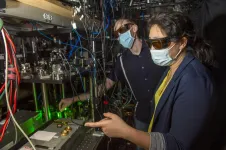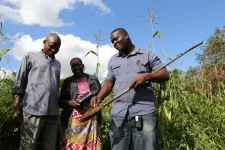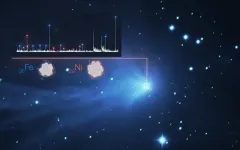FSU researchers uncover new role for strange organisms in ocean food web
2021-05-19
(Press-News.org) Florida State University researchers have more insight into a strange sea creature found in oceans around the world and what their presence means for the health of a marine ecosystem.
Scientists have thought that salps -- small marine organisms that look like clear, gelatinous blobs -- competed for resources with krill, shrimp-like creatures that are an important food source for many marine animals. But new research published in Limnology and Oceanography suggests that salps are actually competing for food with an organism known as a protist.
An image of a salp taken during research. New research published in Limnology and Oceanography suggests that salps are actually competing for food with an organism known as a protist. (Courtesy of Michael Stukel)
"These fascinating and bizarre animals are becoming more abundant in the vast and warming Southern Ocean, so we sought to understand how their presence changes marine ecosystems," said Michael Stukel, a researcher with FSU's Center for Ocean-Atmospheric Prediction Studies and an associate professor in the Department of Earth, Ocean and Atmospheric Science.
Though salps might resemble jellyfish, they are one of the earliest examples of chordates to evolve, and therefore more closely related to humans.
These organisms live in oceans around the world and feed on phytoplankton. When their food source is abundant, salps rapidly multiply with the help of an unusual reproductive cycle, forming large blooms made of thousands of organisms. They remove carbon dioxide from the atmosphere by eating algae and then compacting them into tiny pellets that sink to the bottom of the ocean.
Salps are also a food source for some marine animals, but they don't provide much nutrition. Their importance to the marine food web is eclipsed by krill, which are nutritious food for all sorts of animals, from tiny anchovies to enormous whales. The old theory was that salp blooms crowded out krill, leading to more carbon sequestration but less food for marine organisms.
Instead, salps are probably replacing miniscule protists that are not an important food source for large organisms in the ocean. Although salps are much larger than those protists, they feed on the same microscopic algae. Imagine an elephant that eats the same food as an ant, Stukel said.
To understand what size prey the salps were eating, the researchers built a circular tank and filled it with salps and seawater, which contained their prey. They measured the fluorescence glowing from the salps' prey living in the water and tracked how it changed over time to understand what size prey were being eaten.
Because the protists are the same size as their prey, they needed to use a different method to see what size prey they were eating. The researchers filled one bottle with seawater, which held a typical amount of protists and prey, and another with diluted seawater, which decreased the frequency with which predator and prey met. After 24 hours, they could use the same fluorescence measuring technique to see what kind of prey the protists ate.
Learning that salps are likely competing with protists, and not with krill, is reason to rethink the role of salp blooms in the ocean ecosystem.
"If we get more of these really weird organisms, how is that going to change the way the ocean works -- for everything in the ocean, but also for humans?" Stukel said. "Our results suggest that salps are not even really competing with krill. They're going to be replacing protists, so if that happens, you'll get a lot more carbon sequestration and you'll probably even get a little bit more food availability, because although salps are not as good a prey as krill, they're still better prey than protists."
INFORMATION:
Researchers from the National Institute of Water and Atmospheric Research in New Zealand, Scripps Institution of Oceanography at the University of California San Diego, and the University of Hawaii at Manoa were co-authors on this paper. This research was supported by the National Science Foundation, by New Zealand's Ministry for Business, Innovation and Employment, by the National Institute of Water and Atmospheric Research, and by the Royal Society of New Zealand.
ELSE PRESS RELEASES FROM THIS DATE:
2021-05-19
A heart surgeon doesn't need to grasp quantum mechanics to perform successful operations. Even chemists don't always need to know these fundamental principles to study chemical reactions. But for Kang-Kuen Ni, the Morris Kahn associate professor of chemistry and chemical biology and of physics, quantum spelunking is, like space exploration, a quest to discover a vast and mysterious new realm.
Today, much of quantum mechanics is explained by Schrödinger's equation, a kind of master theory that governs the properties of everything on Earth. "Even though ...
2021-05-19
The amount of nutrients people get from the crops that they eat is a type of 'postcode lottery', according to new research that has analysed thousands of cereal grains and soils as part of a project to tackle hidden hunger in Malawi and Ethiopia.
A global team led by the University of Nottingham and its Future Food Beacon including academics and researchers from Addis Ababa University (AAU) in Ethiopia and Lilongwe University of Agriculture and Natural Resources (LUANAR) in Malawi, working on the GeoNutrition project, have discovered more about the relation between soils, crops and micronutrient deficiencies among people living there. Their ...
2021-05-19
HERSHEY, Pa. -- Parkinson's disease is the second most common neurodegenerative disease and affects more than 10 million people around the world. To better understand the origins of the disease, researchers from Penn State College of Medicine and The Hebrew University of Jerusalem have developed an integrative approach, combining experimental and computational methods, to understand how individual proteins may form harmful aggregates, or groupings, that are known to contribute to the development of the disease. They said their findings could guide the development of new therapeutics to delay or even halt the progression of neurodegenerative diseases.
Alpha-synuclein ...
2021-05-19
A new study by a Belgian team using data from the European Southern Observatory's Very Large Telescope (ESO's VLT) has shown that iron and nickel exist in the atmospheres of comets throughout our Solar System, even those far from the Sun. A separate study by a Polish team, who also used ESO data, reported that nickel vapour is also present in the icy interstellar comet 2I/Borisov. This is the first time heavy metals, usually associated with hot environments, have been found in the cold atmospheres of distant comets.
"It was a big surprise to detect iron and nickel atoms in the atmosphere of all the comets ...
2021-05-19
Where you live may predict your long-term survival after experiencing a first heart attack. Socioeconomic factors -- such as income, education, employment, community safety and more -- have long been associated with cardiovascular health, but less is known about how neighborhood factors impact outcomes after myocardial infarction (MI), particularly among younger individuals. In an article published in JAMA Cardiology, researchers from Brigham and Women's Hospital and colleagues studied the health records of 2,002 patients who experienced an MI at or before age 50. They found that even after adjusting ...
2021-05-19
What The Study Did: Researchers evaluated racial and ethnic diversity among obstetrics and gynecology, surgical and nonsurgical residents in the United States from 2014 to 2019.
Authors: Claudia L. Lopez, M.D., of the University of California, Davis, is the corresponding author.
To access the embargoed study: Visit our For The Media website at this link https://media.jamanetwork.com/
(doi:10.1001/jamanetworkopen.2021.9219)
Editor's Note: The article includes funding/support disclosures. Please see the article for additional information, including other authors, author contributions and affiliations, conflict of interest and financial disclosures, and funding and support.
# ...
2021-05-19
What The Study Did: Registry data were used to examine the association between living in a socioeconomically disadvantaged area and long-term survival among patients who had their first heart attack at or before age 50.
Authors: Ron Blankstein, M.D., of Brigham and Women's Hospital in Boston, is the corresponding author.
To access the embargoed study: Visit our For The Media website at this link https://media.jamanetwork.com/
(doi:10.1001/jamacardio.2021.0487)
Editor's Note: The article includes conflict of interest disclosures. Please see the articles for additional information, including other authors, author contributions and affiliations, conflicts of interest and financial ...
2021-05-19
What The Study Did: This study looked at the use of consumer digital information for COVID-19 control U.S. adults consider to be acceptable and the factors associated with higher or lower approval of using this information.
Authors: David Grande, M.D., M.P.A., of the University of Pennsylvania, is the corresponding author.
To access the embargoed study: Visit our For The Media website at this link https://media.jamanetwork.com/
(doi:10.1001/jamanetworkopen.2021.10918)
Editor's Note: The article includes conflict of interest and funding/support disclosures. Please see the article for additional information, including other authors, author contributions and affiliations, conflict of interest and financial disclosures, and funding and support.
# # #
Media advisory: ...
2021-05-19
What The Study Did: SARS-CoV-2 seropositivity wasn't associated with low levels of vitamin D independently of other risk factors.
Authors: Yonghong Li, Ph.D., of Quest Diagnostics in San Juan Capistrano, California, is the corresponding author.
To access the embargoed study: Visit our For The Media website at this link https://media.jamanetwork.com/
(doi:10.1001/jamanetworkopen.2021.11634)
Editor's Note: The article includes funding/support disclosures. Please see the article for additional information, including other authors, author contributions and affiliations, ...
2021-05-19
What The Study Did: Clinical characteristics and outcomes of patients with multisystem inflammatory syndrome among adults with laboratory-confirmed SARS-CoV-2 infection at a single U.S. medical center are described in this study.
Authors: Giovanni E. Davogustto, M.D., of the Vanderbilt University Medical Center in Nashville, Tennessee, is the corresponding author.
To access the embargoed study: Visit our For The Media website at this link https://media.jamanetwork.com/
(doi:10.1001/jamanetworkopen.2021.10323)
Editor's Note: The article includes conflicts of interest and funding/support disclosures. Please see the article for additional information, including other authors, author contributions and affiliations, conflict of interest and financial disclosures, ...
LAST 30 PRESS RELEASES:
[Press-News.org] FSU researchers uncover new role for strange organisms in ocean food web


